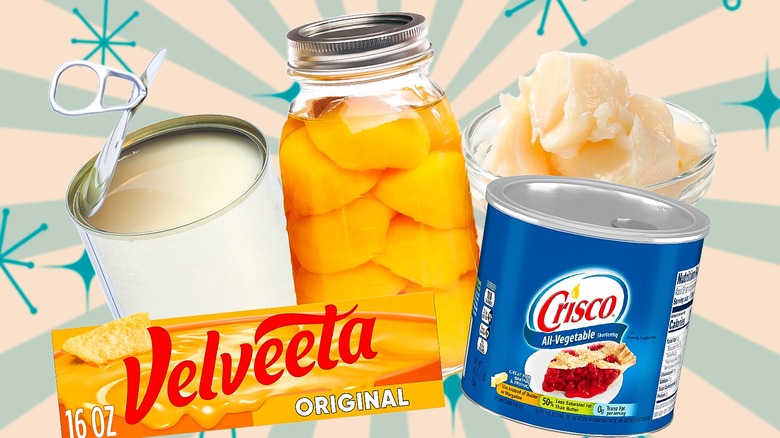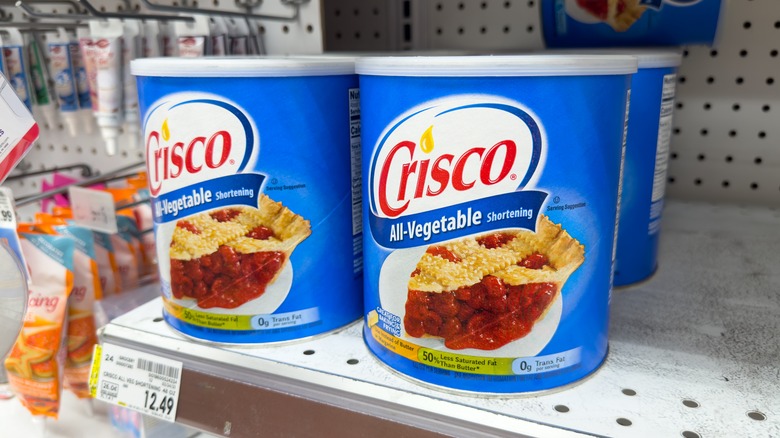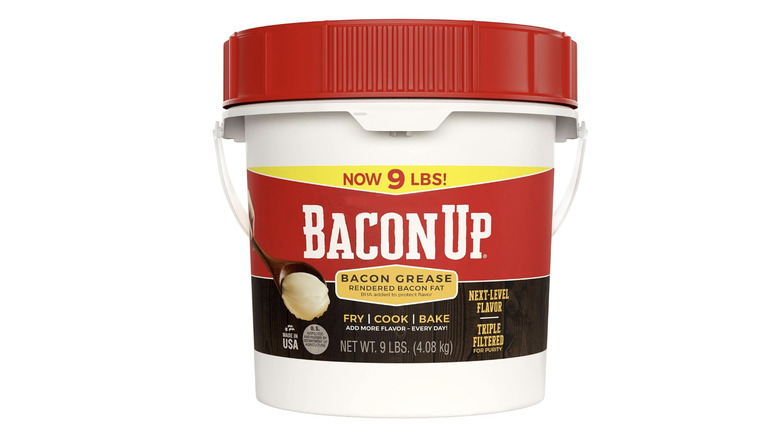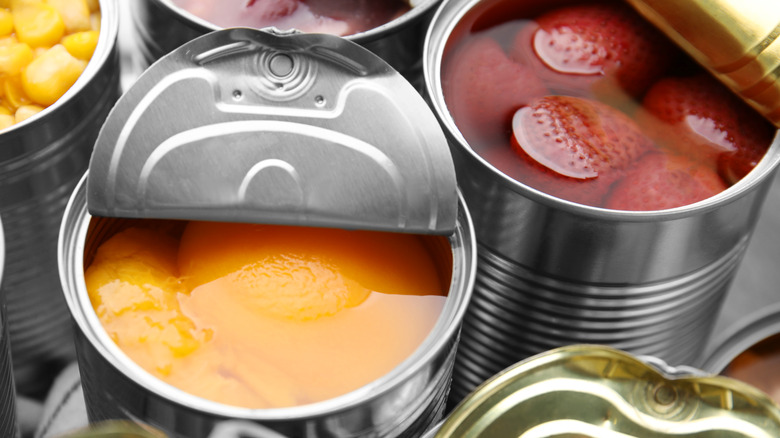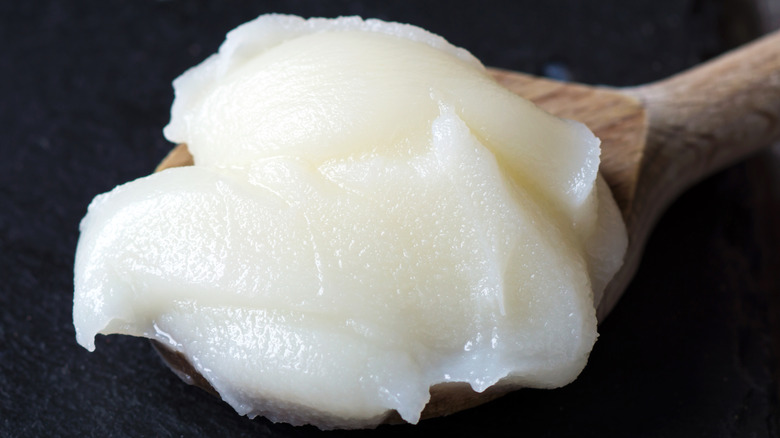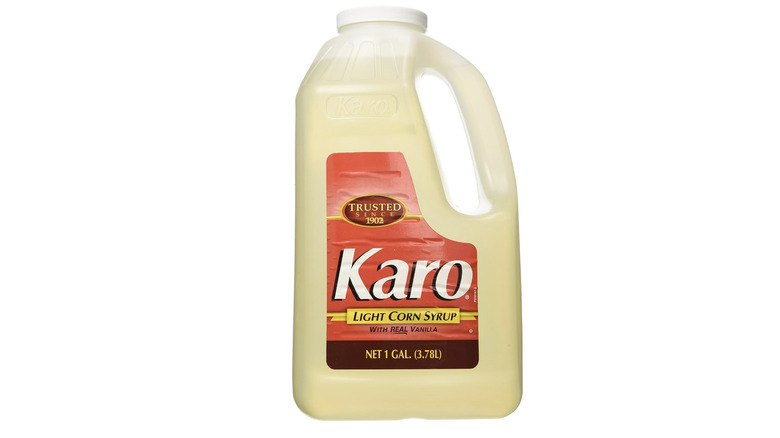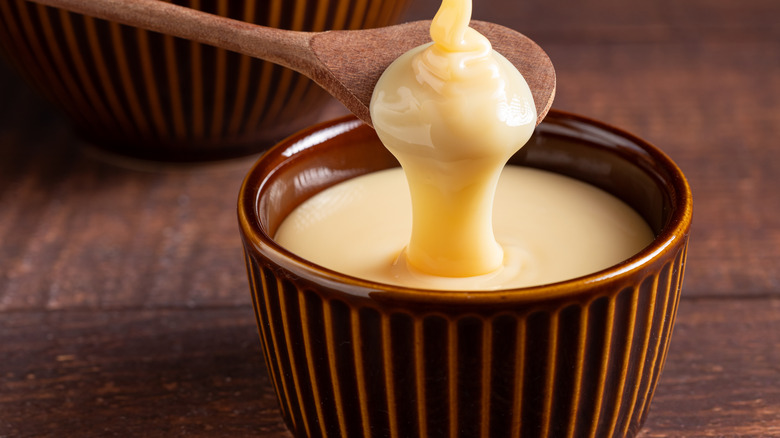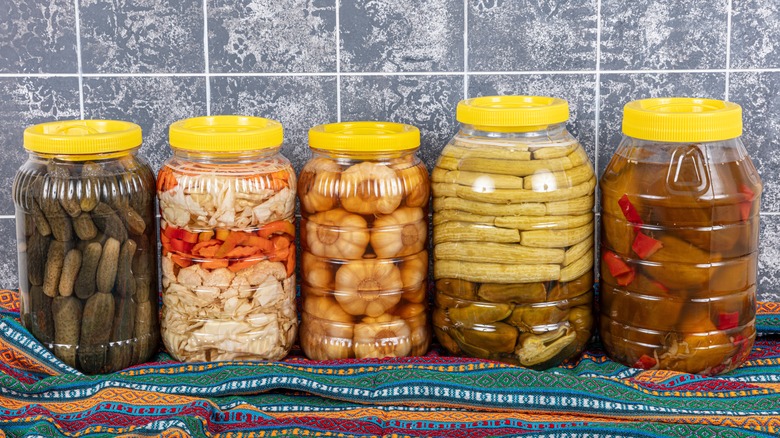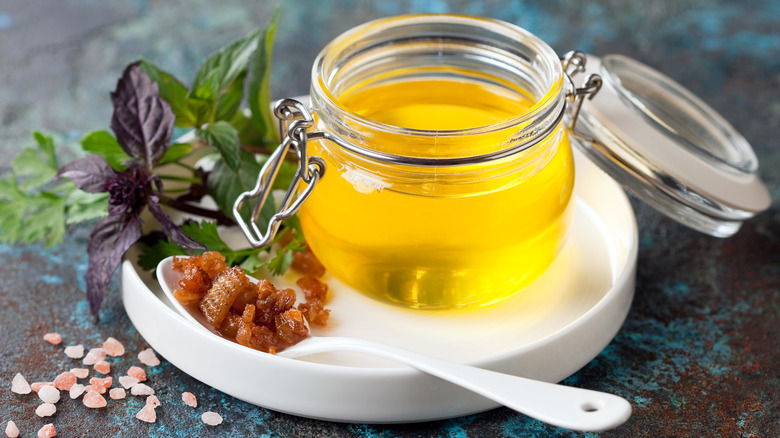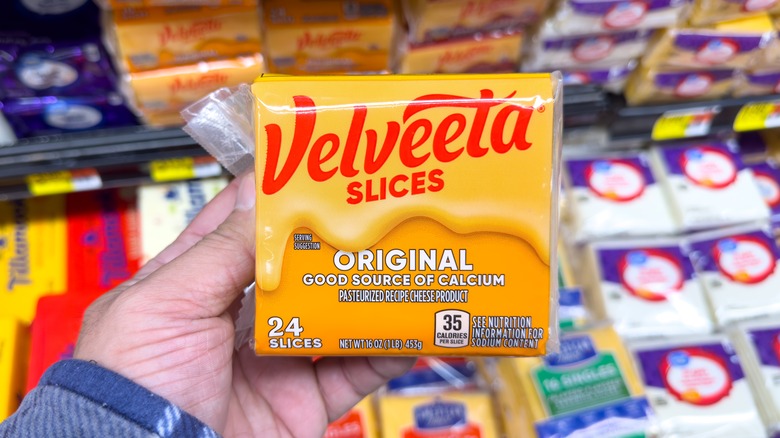11 Old School Ingredients You Shouldn't Be Scared To Use, According To Experts
We may receive a commission on purchases made from links.
Old school ingredients often embody a sense of tradition. Many of these time-tested food items are still in circulation today. Others have faded into obscurity, replaced by more modern, and often more convenient, alternatives. Some of these traditional ingredients have also seen their fair share of controversy, sparking conversations about both health and nutrition. For instance, some foodstuffs that have been demonized in the past have been reevaluated, with new research showing that they can play a part in a balanced diet.
While some old school ingredients have disappeared for a good reason, such as valid concerns about food safety, others have been unfairly sidelined. Some food items, such as lard, have even been replaced with less wholesome alternatives. To get to the bottom of these changes, we have consulted experts in the fields of nutrition and food science. Not only have they clarified the reasons for these shifts, but they have also outlined why some old school ingredients have a rightful place in our kitchens.
Shortening
Shortening is an old school fat usually made from vegetable oils, such as soybean or cottonseed, which used to be turned into solids through a process called hydrogenation. We now know that this processing method created trans fats, which can increase the risk of health problems such as heart disease. The most popular shortening is Crisco, which was invented in the early 20th century to replace lard. Initially made from partially hydrogenated cottonseed oil, today Crisco is produced from palm oil and soybean oil. It also no longer contains trans fats to align with FDA requirements.
While shortening can be substituted with butter in most recipes, the product does have several benefits. Firstly, shortening has a higher melting point than butter, which can result in fluffier and less spread out baked goods. Lisa Lotts, the owner and publisher of the cooking website Garlic and Zest, told Mashed that she likes to use shortening in her fried chicken and cookie recipes. "It improves the texture and mouth-feel of fried chicken, making it extra crispy without tasting greasy," she said. "It's also indispensable for biscuits and gives the perfect crunchy-chewy texture to cookies."
Bacon grease
Long before olive oil, avocado oil, and coconut oil were popular, there was bacon grease. A byproduct of frying or baking bacon, the fat used to be a valuable kitchen staple. Pam Brand, the co-founder of the Southern food blog Biscuits & Burlap, told Mashed that she is fascinated with the preservation of old school recipes and reimagining some of them to be healthier and more in keeping with modern day tastes. One of her favorite ingredients is bacon grease. "In Southern kitchens of old, the cook often kept a strainer-type container on their stove. Anytime they cooked bacon they poured the grease through the strainer so they always had some bacon grease handy," she explained.
While it's unlikely that you'll find bacon grease at your local grocery store, or even a recipe that calls for the ingredient, you can easily collect your own bacon fat and use it instead of butter or oil. In fact, Brand says that her mother always used a little bacon grease to make french fries. "They browned so beautifully because she added a spoonful of bacon grease to the vegetable oil that she cooked them in," she noted. Nevertheless, Brand recommended the grease be used in moderation because it contains saturated fat. "It's like so many of life's pleasures," she said. "Too much butter, wine, beef ... are all bad for you, but enjoyed with some restraint they make for a balanced and happy life."
Canned fruit
Canned fruit has been around since the early 19th century. Ever since then, this convenient preservation method has allowed people to enjoy fruit out of season. While tinned fruit does retain a lot of its nutritional value, it doesn't have the best reputation for being healthy, as explained by food scientist Dr. Bryan Quoc Le. "Some canned fruit requires added sugars to ensure the fruit remains turgid during the heat treatment process used to produce them. The high concentration of sugars ensures the product remains stable throughout its intended shelf life," he said. "[Unfortunately,] the frequent and overconsumption of sugars can increase the risk of certain chronic diseases."
Luckily, not all canned fruit is loaded with added sugar. While it's best to steer clear of fruit that's been canned in heavy syrup since it significantly increases the product's sugar content and calorie count, this isn't the only option. Luckily, canned fruit can also be stored in light syrup, juice, or water, each of which affects the product's sugar content. Recipe developer and food influencer, Kate Thrane, uses canned fruit to make Jell-O, and said she always opts for fruit canned in juice or water and pairs it with a low-sugar or sugar-free gelatin mix to minimize the dessert's sugar content. To stay away from overly sugary canned fruit, the American Diabetes Association has advised looking for phrases such as "unsweetened," "no added sugar," or "packed in its own juices" on the product label.
Lard
A hundred or so years ago, lard was all the rage. In fact, the rendered pig fat used to be a fixture in most kitchens across America. The popularity of lard started declining some time around the 1900s, when new cooking fats began to hit the market, including Procter & Gamble's Crisco shortening. Perhaps the final nail in the coffin for lard came in the 1950s, when healthcare experts started linking the saturated fats in lard with heart disease. This link has since been reevaluated by nutritionists, who now assert that saturated fat doesn't seem to have a link to heart disease risk.
While lard may not appear on top of most shopping lists, the fat has seen a resurgence with supporters praising its flavor and culinary applications. For instance, one self-described home cook on Quora said: "I find lard best for things like standing pie crusts and the like. I use it often in said recipes, or for frying up things I want to add more flavor to. [...] It has a low melting point, but a high smoke point, making it great for some applications. Plus, if you're cooking pork, you have a lot of lard available." Another Quora user agreed, noting, "The beauty of lard is its melting capability and the way it caramelizes food. There are [only] a few things that can do it the same way."
Canned soups
While canned soups can be enjoyed on their own, they also make a great addition to countless recipes. Some of the recipes that use a can of soup include casseroles, stews, and even breakfast dishes. For instance, adding a can of cream of mushroom soup to a casserole can give it a rich and creamy texture. Individuals who enjoy experimenting in the kitchen can also use a can of tomato soup as a hearty base for a marinara sauce.
Canned soups get a bad rap and for a good reason. Many canned soups are packed with sodium, and calories, which can lead to health issues, including obesity, bloating, and hypertension. However, the news isn't all negative, provided that you know a thing or two about reading food labels. According to dietician Melissa Meier, there are a few telltale signs you should look for when choosing your next can of soup. Aside from looking for soup with under 700 milligrams of sodium per serving, make sure that the product is made up of at least 50% vegetables. In addition, it's best to select soups with protein-rich ingredients such as legumes, beef, or chicken (via Healthy Food Guide).
Corn syrup
Corn syrup is a sweetener made by breaking down corn starch into glucose. To make it sweeter, this mixture is commonly fortified with enzymes that turn some of the glucose into fructose. High fructose corn syrup typically contains either 42% or 55% of fructose, with the former used in baking. Kate Thrane, the manager of the blog The Glutenless Maximus, is well-versed in the benefits of this sweetener. "Corn syrup helps to prevent crystallization in candies and sweets, ensuring a smooth, velvety texture. It's also great for providing a glossy finish and maintaining moisture in baked goods," she said, adding that corn syrup can be used to make old-fashioned caramels.
Corn syrup is often vilified for its high fructose content, which has been linked to an increased risk of chronic diseases and metabolic disorders. However, there are certain measures home chefs can take to minimize the risks. "To make treats healthier, use corn syrup sparingly and pair it with natural ingredients. For example, in caramel recipes, combine it with real butter and cream to create a more balanced treat," Thrane explained. In addition, not all corn syrups are created equal with some healthier than others, as pointed out by Lisa Lotts from Garlic and Zest. "The most commonly sold corn syrup (Karo) doesn't contain high fructose," said Lotts. "I use it in my popular cherry ice cream recipe. It doesn't need a lot, but it makes a big difference in the outcome."
Condensed milk
Often used to make desserts such as poke cake and dulce de leche, condensed milk is created by heating up regular milk to remove water. This process also caramelizes the sugars in the milk, resulting in a thick and creamy liquid. In addition, condensed milk is often fortified with regular sugar, which is used to extend the product's shelf-life. Kate Thrane explained that condensed milk is incredibly versatile. "It adds richness and sweetness to desserts without the need for additional sugar. Plus, it's a key ingredient in no-churn ice creams, making creamy desserts easier to whip up at home," she said.
While it's frequently the sweetness of condensed milk that makes it such a hit, Dr. Bryan Quoc Le, food scientist and the author of "150 Food Science Questions Answered," told Mashed that it's also what makes it problematic. More specifically, Quoc Le warns that sweetened condensed milk is very caloric. While Thrane agreed with this assessment, she also said she doesn't believe we need to give up condensed milk altogether. "Condensed milk is high in sugar and calories, which can be a concern for those watching their sugar intake or trying to maintain a balanced diet. [...] For a healthier twist, use condensed milk in recipes that incorporate fresh fruits or natural flavorings. This can help enhance the nutritional profile of your desserts."
Pickled foods
Pickling is a method of jarring food in vinegar or brine to preserve it. This process not only helps to extend the shelf life of various foods, but can also be used to imbue them with flavor. Dating back to approximately 2400 B.C., pickling food has been an important preservation technique across the globe. Even Cleopatra is said to have eaten pickles as a part of her beauty routine. Today, pickled food remains popular worldwide. Some of the more common types include sauerkraut from Germany and kimchi from Korea.
Despite its popularity, not everybody is a fan of pickled food, calling it out for its high sodium content. For instance, a medium-sized pickle contains around 780 milligrams of sodium. This is a lot since the USDA recommends that adults don't exceed 2,300 milligrams of sodium per day. Cynthia Sass, a nutritionist and registered dietitian, said that consuming pickled foods is fine as long as you don't go overboard. "It could be healthy to eat pickles daily, as long as they're eaten in moderation — one or two spears or a few pickle chips might be OK," she wrote in an article for Health. According to Sass, those looking for the probiotic benefits associated with pickled foods should look for items that have been fermented rather than pickled in the usual way.
Duck fat
While this may come as a surprise to some, duck fat can be a healthy alternative to other fats. Although the product includes 28% saturated fat, it's also made up of oleic and linoleic acids, which are unsaturated fatty acids also found in olive oil and avocados. Both oleic and linoleic acids have been lauded for their antioxidant and anti-inflammatory effects. In addition, duck fat is pretty efficient, which means that a spoonful of the grease can replace a generous amount of olive oil.
Lisa Lotts from Garlic and Zest highlights that duck fat is one of her favorite "specialty" old school ingredients because it's completely natural, coming from rendered and strained duck. "Duck fat is especially good for roasting potatoes to give them a crispy, but never greasy exterior. It's also indispensable for confit, preserving duck legs (or chicken) in fat," she said. Lotts also gives Mashed readers some storage tips, saying that duck fat can go rancid and should be refrigerated after opening. "If it won't be used immediately, I freeze leftover duck fat until I need it. It will last three to four months in the freezer," she explained.
Artificial sweeteners
Artificial sweeteners contain no sugar or calories. Instead, many are made from a range of chemicals and can be between 200 to 700 times as sweet as regular sugar. Over the years, sugar substitutes have been linked to a whole lineup of health issues, from heart disease to cancer. But, health agencies have since reevaluated them, advising that they do not cause serious health problems. In fact, the Food and Drug Administration has approved six artificial sweeteners: saccharin, advantame, neotame, sucralose, acesulfame potassium, and aspartame. The only caveat is that aspartame shouldn't be consumed by people with phenylketonuria, a genetic disorder that makes it difficult to process phenylalanine, which is one of the ingredients in the sweetener.
While artificial sweeteners have received their share of bad press, they do have some health benefits beyond helping consumers manage weight. They can also be beneficial for people with diabetes who need to control their blood sugar levels. A less obvious benefit of replacing sugar with an artificial sweetener is a reduction in tooth decay and cavities. Nevertheless, individuals who choose to use artificial sweeteners should pay careful attention to product labels to ensure that they don't go over the recommended daily consumption limit.
Velveeta cheese
Velveeta is the brainchild of a Swiss immigrant Emil Frey who invented the product in 1918 using cheese scraps salvaged from the Monroe Cheese Company where he worked. Lora Vogt, food historian and curator at the World War I Museum and Memorial in Kansas City, clarified the story in an interview with Allrecipes: "The organization sent cheese scraps to Frey to experiment with at home and he found that by adding cheese byproducts like whey to the scraps, the end result was velvety in consistency. [...] Due to its velvety texture when melted, Frey named it Velveeta."
While Velveeta contains milk and cheese culture, it technically isn't cheese. Instead, the grocery item is labeled as a "pasteurized prepared cheese product." The mild and creamy cheese substitute may not be the healthiest item in your fridge, as Dr. Bryan Quoc Le explained. "Velveeta cheese contains high levels of sodium, which may increase blood pressure and exacerbate cardiovascular conditions," he said. The product also has a lot of fat and calories. Nevertheless, if you find yourself hankering for a little Velveeta, the news isn't all bad. The cheese product is also a decent source of protein and calcium, and is lactose-free.
